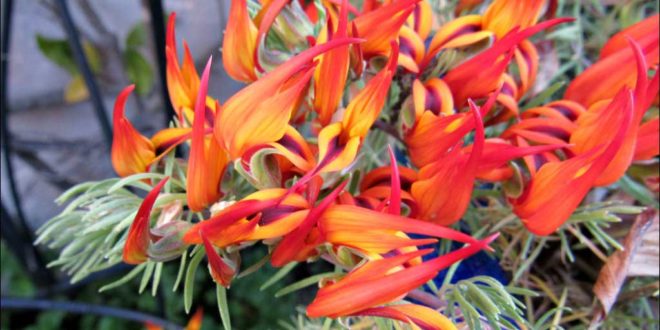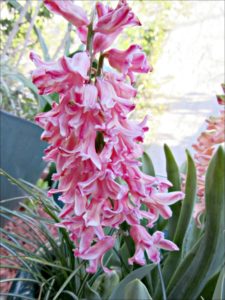We had average March weather in our Sunnyvale garden: about 8 days of rain but less in volume than February. We still had a lot of flowers: Pea-shrub, orinthogalum, several types of crocus, daffodils, tulips, hyacinths, freesia, armeria, plum, apricot, flowering plum, viola, cyclamen, english daisy, yarrow, bacopa, lavendar. On the vegetable side: cilantro, tomatoes, beet, garlic, rhubarb, chile, basil. Lots of spring growth: swartzkopf, mulberry, figs, milkweed, foxglove, caesurium, bleeding-heart, lily-of-the-valley, verbascum, geranium. Most of the tomatoes are in the final pots. The mulberry tree is flowering.
On tap for April: asiatic lily, squill, christmas amaryllis, foxglove
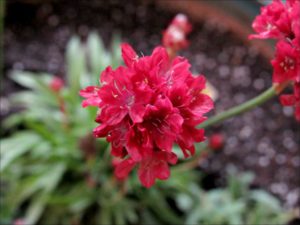 Another first in 2017 for our Sunnyvale garden: Sea pink. Armeria maritima, commonly called thrift or sea pink, is a compact, low-growing plant which forms a dense, mounded tuft of stiff, linear, grass-like, dark green leaves (to 4″ tall). Tufts will spread slowly to 8-12″ wide. Tiny, pink to white flowers bloom in mid spring in globular clusters (3/4-1″ wide) atop slender, naked stalks rising well above the foliage to 6-10″ tall. Sporadic additional flowering may occur throughout the summer. Flower clusters are subtended by purplish, papery bracts. We are growing it in a wide shallow pot (15×4) with orinthigalum and tiger eye viola.
Another first in 2017 for our Sunnyvale garden: Sea pink. Armeria maritima, commonly called thrift or sea pink, is a compact, low-growing plant which forms a dense, mounded tuft of stiff, linear, grass-like, dark green leaves (to 4″ tall). Tufts will spread slowly to 8-12″ wide. Tiny, pink to white flowers bloom in mid spring in globular clusters (3/4-1″ wide) atop slender, naked stalks rising well above the foliage to 6-10″ tall. Sporadic additional flowering may occur throughout the summer. Flower clusters are subtended by purplish, papery bracts. We are growing it in a wide shallow pot (15×4) with orinthigalum and tiger eye viola.
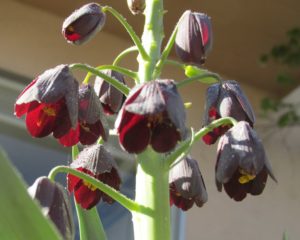 Persian Fritillary. Spikes of deep maroon bells create an intriguing focal point in the spring garden. The tall stems are clothed with gray-green leaves, which are attractive in their own right. The Persian fritillary usually requires a season or two to establish itself. The Persian Fritillary was introduced into English gardens in the late sixteenth century. Bernard McMahon, Jefferson’s gardening mentor, listed the Fritillaria persica on his 1810 broadsheet.
Persian Fritillary. Spikes of deep maroon bells create an intriguing focal point in the spring garden. The tall stems are clothed with gray-green leaves, which are attractive in their own right. The Persian fritillary usually requires a season or two to establish itself. The Persian Fritillary was introduced into English gardens in the late sixteenth century. Bernard McMahon, Jefferson’s gardening mentor, listed the Fritillaria persica on his 1810 broadsheet.
Some North American species,called mission bells (F. affinis), are California natives. They can be found up and down the San Mateo peninsula in places like Edgewood Preserve and Windy Hill.
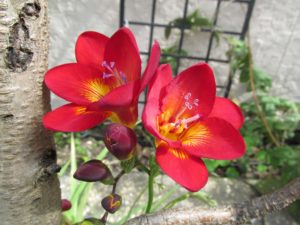 Freesia is a fragrant pretty spring corm that naturalizes so it comes back year after year. I plant them at the bases of the fruit trees and in containers to provide some of the first blooms and scents of spring. Freesia flowers are “zygomorphic” which just means that they grow along one side of the stem, in a single plane. When you look at a flower stalk however, you’ll see that the blooms are facing upwards. How does this work? Freesias stems have the unusual habit of turning at right angles just below the bottom flower. This causes the upper portion of the stem to grow almost parallel with the ground. The flowers bloom along the top side of the stalk, facing upwards.
Freesia is a fragrant pretty spring corm that naturalizes so it comes back year after year. I plant them at the bases of the fruit trees and in containers to provide some of the first blooms and scents of spring. Freesia flowers are “zygomorphic” which just means that they grow along one side of the stem, in a single plane. When you look at a flower stalk however, you’ll see that the blooms are facing upwards. How does this work? Freesias stems have the unusual habit of turning at right angles just below the bottom flower. This causes the upper portion of the stem to grow almost parallel with the ground. The flowers bloom along the top side of the stalk, facing upwards.
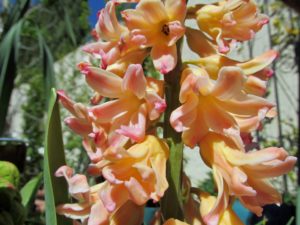 We grow hyacinth in our Sunnyvale garden most years. In 2017 the first bloom was the first week in March, after the crocus have finished blooming, and right before the tulips start blooming. Attractive to bees, butterflies and/or birds. Flowers are fragrant.They make excellent cuttings.
We grow hyacinth in our Sunnyvale garden most years. In 2017 the first bloom was the first week in March, after the crocus have finished blooming, and right before the tulips start blooming. Attractive to bees, butterflies and/or birds. Flowers are fragrant.They make excellent cuttings.
The genus is native to the eastern Mediterranean (from the south of Turkey through to northern Israel). This plant is suitable for growing indoors. Muscari aka grape hyacinth, is a different genus than the Dutch hyacinth. Muscari naturalizes and comes up every year. The Dutch Hyacinth does best if planted new every year.
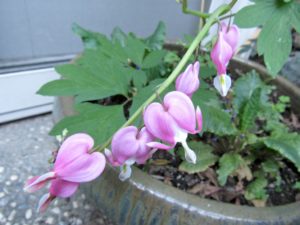 The bleeding heart plant has heart-shaped flowers that hang in rows on arching stems above soft, green foliage. This spring-blooming perennial has a short growing season. By midsummer, the whole plant dies back to the ground. Like other herbaceous perennials, bleeding heart grows for many seasons from underground roots, but the plant’s life cycle differs from that of many other perennials. Most perennials die back at the end of the growing season, in late fall and early winter. Bleeding heart, however, dies back to the ground by midsummer. The plant remains dormant through the rest of the year and grows again in late winter or early spring. The plant takes two to five years to reach its mature height.
The bleeding heart plant has heart-shaped flowers that hang in rows on arching stems above soft, green foliage. This spring-blooming perennial has a short growing season. By midsummer, the whole plant dies back to the ground. Like other herbaceous perennials, bleeding heart grows for many seasons from underground roots, but the plant’s life cycle differs from that of many other perennials. Most perennials die back at the end of the growing season, in late fall and early winter. Bleeding heart, however, dies back to the ground by midsummer. The plant remains dormant through the rest of the year and grows again in late winter or early spring. The plant takes two to five years to reach its mature height.
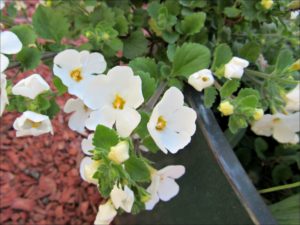 Marie and I visited the Albuquerque arboreteum this past fall. I was impressed with 3 layer pots called Thrillers-Fillers-Spillers. So I made one at home with Lion’s Tail, society garlic, and white bacopa. Bacopa (Sutera cordata) is available in most nurseries. In our climate (zone 9) you usually treat bacopa as an annual. The flowers are produced solitary or in pairs from leaf axil, usually radially symmetrical, sepals 5, petals 5, usually white, blue or purple in color. Dispersal and propagation is by seeds and stem fragments. Crushed leaves have a distinctive ‘lemon’ scent.
Marie and I visited the Albuquerque arboreteum this past fall. I was impressed with 3 layer pots called Thrillers-Fillers-Spillers. So I made one at home with Lion’s Tail, society garlic, and white bacopa. Bacopa (Sutera cordata) is available in most nurseries. In our climate (zone 9) you usually treat bacopa as an annual. The flowers are produced solitary or in pairs from leaf axil, usually radially symmetrical, sepals 5, petals 5, usually white, blue or purple in color. Dispersal and propagation is by seeds and stem fragments. Crushed leaves have a distinctive ‘lemon’ scent.
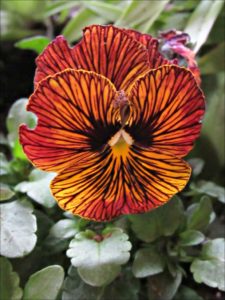
“Tiger Eyes” is a new viola for 2017. 1” bright golden yellow flowers have black perfectly clear radiating veins around a central black eye. 6”-8” tall and 10” spread. Very Fragrant. I got them this year for Marie for Valentine’s Day.
Some Viola species are perennial plants, some are annual plants, and a few are small shrubs. A large number of species, varieties and cultivars are grown in gardens for their ornamental flowers.
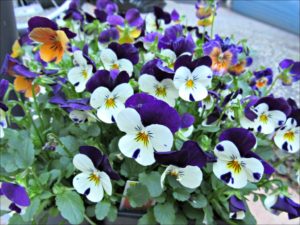 In horticulture the terms “viola” and “violet” are normally reserved for small-flowered annuals or perennials, including the species. The term “pansy” is normally used for those multi-coloured, large-flowered cultivars which are raised annually or biennially from seed and used extensively in bedding. Hardy in U.S. Department of Agriculture plant hardiness zones 3 through 9, violas and pansies are a colorful addition to your home when grown as a houseplant.
In horticulture the terms “viola” and “violet” are normally reserved for small-flowered annuals or perennials, including the species. The term “pansy” is normally used for those multi-coloured, large-flowered cultivars which are raised annually or biennially from seed and used extensively in bedding. Hardy in U.S. Department of Agriculture plant hardiness zones 3 through 9, violas and pansies are a colorful addition to your home when grown as a houseplant.
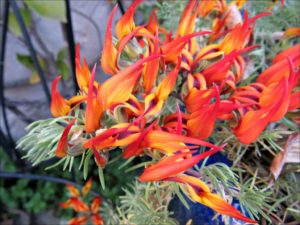 The stunning, brightly colored unusually shaped blooms of the evergreen trailing plant Lotus berthelotii, commonly called parrot’s beak, brings a tropical feel to your garden or landscape. Native to the Canary and Cape Verde Islands off the west coast of Africa, Parrot’s beak is a sun-loving perennial that can be grown as an annual in areas below U.S. Department of Agriculture plant hardiness zone 10.
The stunning, brightly colored unusually shaped blooms of the evergreen trailing plant Lotus berthelotii, commonly called parrot’s beak, brings a tropical feel to your garden or landscape. Native to the Canary and Cape Verde Islands off the west coast of Africa, Parrot’s beak is a sun-loving perennial that can be grown as an annual in areas below U.S. Department of Agriculture plant hardiness zone 10.
Parrot’s beak can also grow as a tropical houseplant or hanging plant, providing year-round greenery indoors. The silver-gray needle-like lives, spaced along the stems in attractive whorls, contrast with the pea-like, 1 in. long bright crimson flowers.
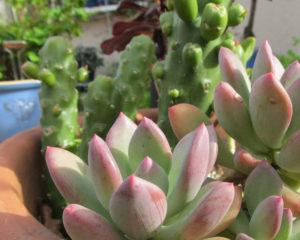 All of the succulents in our Sunnyvale garden loved the wet winter.
All of the succulents in our Sunnyvale garden loved the wet winter.
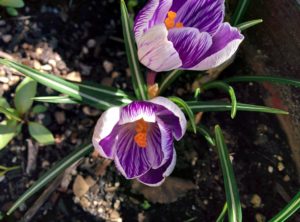 Giant Dutch Crocus “Pickwick’ bears large, cup-like silver-lilac flowers with darker lilac stripes. Vigorous, long-lived and naturalizes easily, this crocus belongs to the Crocus vernus group. Pickwick crocus blooms later in February, for about 3 weeks. The calyx-shaped flowers only open in the sun, they close in rainy weather.
Giant Dutch Crocus “Pickwick’ bears large, cup-like silver-lilac flowers with darker lilac stripes. Vigorous, long-lived and naturalizes easily, this crocus belongs to the Crocus vernus group. Pickwick crocus blooms later in February, for about 3 weeks. The calyx-shaped flowers only open in the sun, they close in rainy weather.
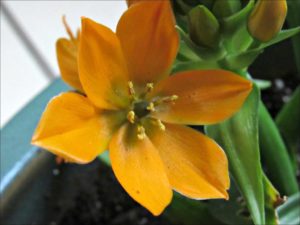 Bring a touch of Africa to your yard with the brilliant orange Ornithogalum dubium.Mediterranean climate like California. Commonly called star of Bethlehem, orange star flower, snake flower or chincherinchee, this bulb is hardy in USDA planting zones 7 through 11, and can be enjoyed as a tender bulb or a potted plant elsewhere. The plant grows up to a foot tall and blooms with clusters of 15 to 20 small six-petaled blossoms on 12 to 15-inch stems in spring. Orange star flower makes an attractive rock garden or woodland plant where they can naturalize in a site that receives full sun.
Bring a touch of Africa to your yard with the brilliant orange Ornithogalum dubium.Mediterranean climate like California. Commonly called star of Bethlehem, orange star flower, snake flower or chincherinchee, this bulb is hardy in USDA planting zones 7 through 11, and can be enjoyed as a tender bulb or a potted plant elsewhere. The plant grows up to a foot tall and blooms with clusters of 15 to 20 small six-petaled blossoms on 12 to 15-inch stems in spring. Orange star flower makes an attractive rock garden or woodland plant where they can naturalize in a site that receives full sun.
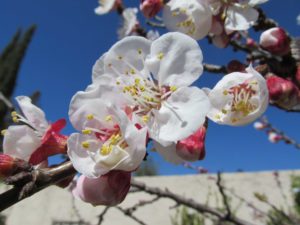 The first apricot blossoms of 2017. We have 2 trees: A semi-dwarf planted in a former hot tub; and a volunterthat grew from a thrown-away pit. Because it grew from a pit, it is standard size.
The first apricot blossoms of 2017. We have 2 trees: A semi-dwarf planted in a former hot tub; and a volunterthat grew from a thrown-away pit. Because it grew from a pit, it is standard size.
The Royal Blenheim is the best apricot in the world. All-purpose freestone. Sweet, aromatic, flavorful – the long-time No. 1 apricot in California. Early bloom. Chilling requirement 400 hours or less (under 45 degerees), which is fine for Sunnyvale. Blenheims typically have their first blossoms in the 3rd week of February. One hundred and twenty days later, their harvest comes all at once the last week of June.
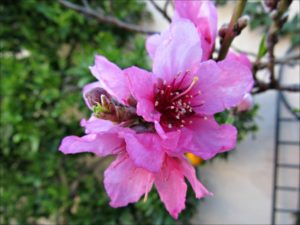 Our nectarine trees always have spectacular blossoms. Too bad they never have had great harvests. I bought the trees bare-root with ultra-dwarf rootstock because I knew they were going into smaller ten-gallon pots. Nectarines get peach-leaf-curl almost every year; a fungus that kills many leaves.
Our nectarine trees always have spectacular blossoms. Too bad they never have had great harvests. I bought the trees bare-root with ultra-dwarf rootstock because I knew they were going into smaller ten-gallon pots. Nectarines get peach-leaf-curl almost every year; a fungus that kills many leaves.
Last year, a drought year, we had about a dozen ripe fruits. “Had” is the operative word. The next morning they were all gone. We asked the squirrels sitting on the fence if they had seen them. They just shook their heads from side to side and spat out a pit.
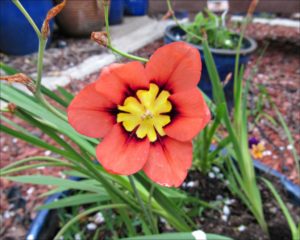 Sparaxis, also known as wandflower or harlequin flower, are colorful members of the iris family with open star-shaped white, orange, lavender, yellow or pink flowers often centered with contrasting symmetrical patterns. The plants are ideal for Sunnyvale gardens as they are hardy to USDA zones 9 through 11. In warm-winter zones, sparaxis should be planted in the fall. Sparaxis are adapted for areas where there are fall, winter and spring rains and dry, hot summers. After they bloom, the foliage dies down and the bulb goes dormant until the next growing season — fall in warm-winter climates, spring in cold-winter climates. For bulbs that remain in the ground, cut off rather than pull loose the dried foliage.
Sparaxis, also known as wandflower or harlequin flower, are colorful members of the iris family with open star-shaped white, orange, lavender, yellow or pink flowers often centered with contrasting symmetrical patterns. The plants are ideal for Sunnyvale gardens as they are hardy to USDA zones 9 through 11. In warm-winter zones, sparaxis should be planted in the fall. Sparaxis are adapted for areas where there are fall, winter and spring rains and dry, hot summers. After they bloom, the foliage dies down and the bulb goes dormant until the next growing season — fall in warm-winter climates, spring in cold-winter climates. For bulbs that remain in the ground, cut off rather than pull loose the dried foliage.
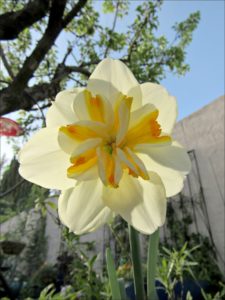 The flowers of double daffodils or narcissi are multi-layered, each different in their own way. These unique flowers are either full flowered or interspersed with smaller petals with contrasting colours. Daffodil flowers have a trumpet-shaped structure set against a star-shaped background.
The flowers of double daffodils or narcissi are multi-layered, each different in their own way. These unique flowers are either full flowered or interspersed with smaller petals with contrasting colours. Daffodil flowers have a trumpet-shaped structure set against a star-shaped background.
Flowers in this group are better planted in a sheltered position where you can enjoy their distinctive show. They have one flower to the stem with a doubling of the perianth segments or corona or both.
The classic paper-white narcissus blooms in our Sunnyvale garden (USDA zone 9) starting in November. The daffodils and double daffodils bloom in March.
Daffodils are native mainly to the Mediterranean region, in particular to the Iberian Peninsula, as well as Northern Africa and the Middle East.
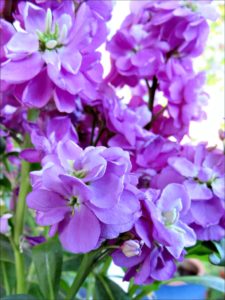 Stock offers a wonderfully spicy, distinctive scent. In Sunnyvale, plant it in spring as earlier as February — this annual thrives in cool temperatures and stops blooming once hot weather arrives. It’s especially wonderful in window boxes and planters at nose level, where its sometimes subtle effect can best be appreciated.
Stock offers a wonderfully spicy, distinctive scent. In Sunnyvale, plant it in spring as earlier as February — this annual thrives in cool temperatures and stops blooming once hot weather arrives. It’s especially wonderful in window boxes and planters at nose level, where its sometimes subtle effect can best be appreciated.
Stock is slightly spirelike and comes in a wide range of colors. It makes a great cut flower, perfuming bouquets as well as the border. It grows best in full sun or part shade and moist, well-drained soil.
The majority of tulips (Tulipa spp.) flower naturally in the spring, making them a symbol of new life and renewal. Many varieties of tulips produce blooms in varying shades of yellow, adding a cheerful “hello” to the new growing season. Yellow tulips require the same care and maintenance as other colored tulip varieties.
Daffodils (Narcissus spp.) and tulips (Tulipa spp.) are often the first flowers of spring. Daffodils are available for U.S. Department of Agriculture plant hardiness zones 3 through 11, while tulips grow in USDA zones 3 through 9. Most daffodils feature bright yellow tubular flowers, while tulips come in a rainbow of colors. Mixing the two bulbs in a single bed creates a colorful spring display and can increase the flowering period if you mix early-flowering daffodils with midseason or late-blooming tulips. Both flowers grow best with full, all-day sunlight.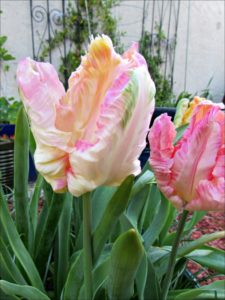
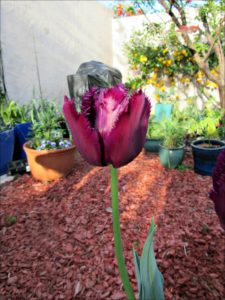
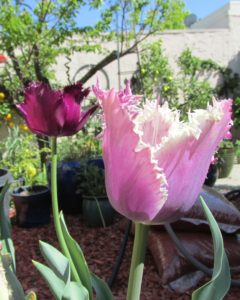
Pink Hyacinth. We grow hyacinth in our Sunnyvale garden most years. In 2017 the first bloom was the first week in March, after the crocus have finished blooming, and right before the tulips start blooming. Attractive to bees, butterflies and/or birds. Flowers are fragrant. This plant is suitable for growing indoors. Muscari aka grape hyacinth, is a different genus than the Dutch hyacinth. Muscari naturalizes and comes up every year. The Dutch Hyacinth does best if planted new every year.
Dutch Hyacinth, Hyacinthus orientalis. Hyacinthus is a small genus of bulbous, fragrant flowering plants in the family Asparagaceae, subfamily Scilloideae. These are commonly called hyacinths. The genus is native to the eastern Mediterranean (from the south of Turkey through to northern Israel). Average Water Needs; Water regularly; do not overwater. Flowers are good for cutting.
 After 5 years, our Wisteria is finally flowering! Wisteria is a beautiful spring vine. Because of my visits to the California Spanish missions, I cannot think of Wisteria without thinking of California.
After 5 years, our Wisteria is finally flowering! Wisteria is a beautiful spring vine. Because of my visits to the California Spanish missions, I cannot think of Wisteria without thinking of California.
I planted my wisteria in probably the worst spot for it in our Sunnyvale garden: a spot nestled in an east-facing corner that only gets a few hours of sunlight per day. All of the good sunny spots are already claimed. After five years, the vines have reached the 8-foot high wall and now I am training them to run along that wall and also up the taller A-frame portion of the house. The extra sunlight has produced flowers this year.
The Santa Clara de Asis mission in Santa Clara has the oldest wisteria in Northern California; along with mission olive trees planted by Franciscan friars in 1822; a giant 123-year-old Jacaranda tree; and heritage rose garden.
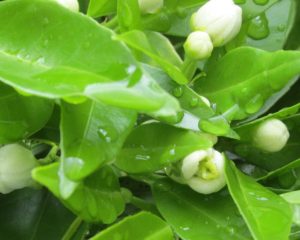 All of our citrus trees are blossoming: grapefruit, tangerine, orange, lemon, and lime. They loved the wet winter and all have lots of blossoms.
All of our citrus trees are blossoming: grapefruit, tangerine, orange, lemon, and lime. They loved the wet winter and all have lots of blossoms.
